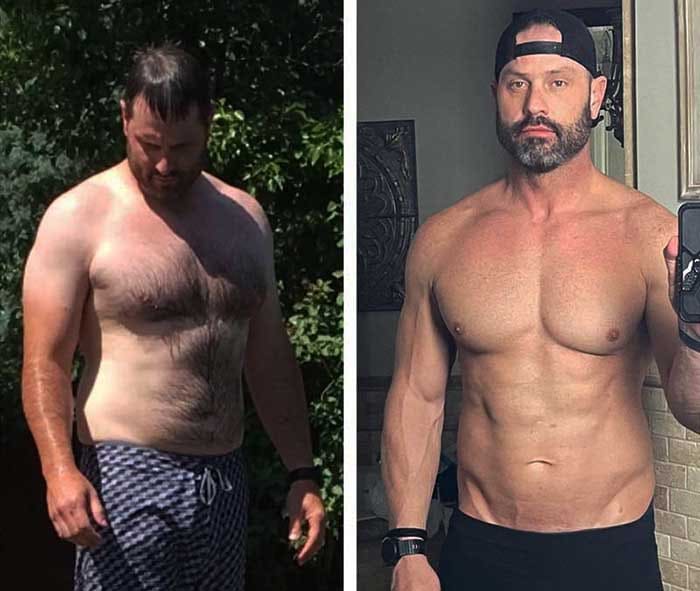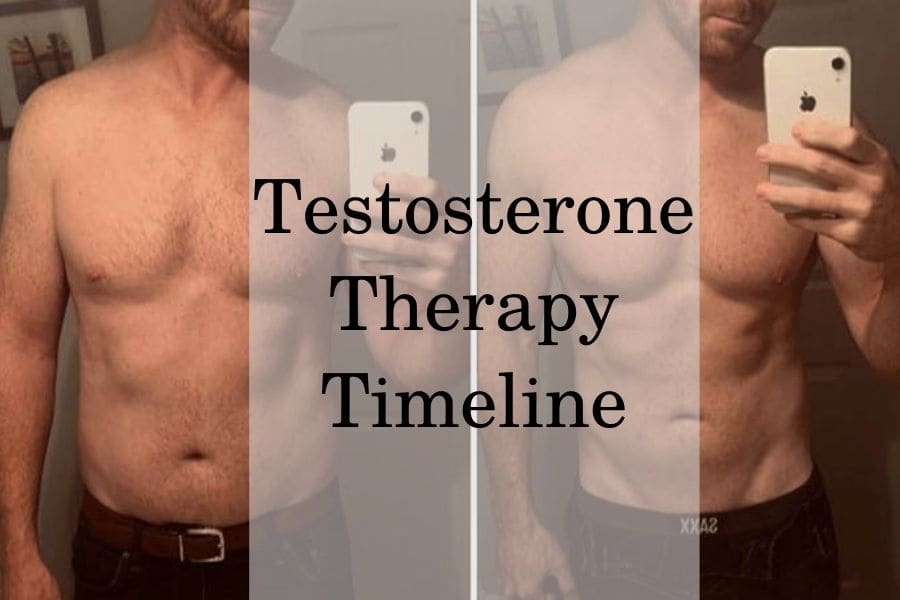Testosterone replacement therapy (TRT) is a treatment option for men with hypogonadism, which can deliver quick results depending on your symptoms, dosage, and medication form.
Even though it is one of the quickest methods to manage the symptoms of low testosterone (T), keep in mind that the results won’t appear within a day. It takes 3-4 weeks of TRT until you notice the first benefits.
Off-label use of testosterone for athletic performance or physique enhancement is illegal and should be avoided. Besides, it often involves illegal products which might not deliver the benefits as promised.
What results to expect from testosterone treatment?
One of the most valuable effects to expect when you undergo testosterone treatment is fat loss, improved metabolic and cardiovascular health.
These benefits have an impact on overall health and longevity. Also, testosterone has a powerful anabolic effect leading to increased muscle mass, energy levels, and bone density.
TRT delivers exogenous testosterone into the human body and increases the serum T levels back to physiological levels. Studies report that hypogonadism is associated with increased all-cause mortality while TRT may reduce that risk.
Furthermore, some of the most valuable results for men include the benefits of testosterone therapy on libido and erectile function. Also, it can also improve mood, cognition, and quality of life in hypogonadal patients.
TRT can come in various forms which have different bioavailability, absorption rate, and side effects. Testosterone injections lead to the quickest rise in serum T level and thus help you manage your symptoms faster than other forms.
Testosterone levels increase right after the first injection, sometimes reaching supraphysiological levels for a short time. Nevertheless, achieving noticeable improvement takes up to a month.
A second injection can be applied shortly (1-4 weeks) after the first one in order to alleviate the symptoms quickly.
Timeline of testosterone therapy benefits
We have established a relative timeline of all the benefits you may expect during your treatment.
The first results of the therapy occur after 3-4 weeks, but most of the benefits take longer. Usually, it takes months or years of testosterone therapy to achieve the maximum results in all possible aspects.
Here is a timeline of the benefits you can expect each month of TRT according to science:
Month 1
The first results of TRT occur towards the end of the first month and include improvements in sexual function, desire, and quality of life. According to a trial in 40 hypogonadal men, libido increases on the 3rd week of therapy and hits a plateau after 6 weeks. Erectile function improves after a slightly longer period – 3 to 9 weeks of TRT.
Furthermore, there are noticeable improvements in some markers of inflammation which may continue to improve for several months during the treatment.
Month 2
Total cholesterol levels decrease during TRT, starting at the 2nd month of therapy. However, significant improvements in your lipid profile including a reduction in LDL and triglycerides occur after the 3rd month and may continue for more than 12 months.
Moreover, after 6-9 weeks TRT improves mood and reduces symptoms of depression.
Month 3
During the third month of therapy, there already are noticeable changes in body composition, which continue improving in the following months.
Studies report that main changes involve fat loss, an increase in lean body mass, and improved physical performance. Testosterone has powerful anabolic effects which improve muscle mass, strength, and endurance.
Simultaneously testosterone has catabolic effects on adipose tissue and stimulates fat loss
Patients on TRT with anemia can benefit from increased erythropoiesis (the production of red blood cells) which occurs after 12 weeks of treatment.
Month 6
Testosterone therapy lasting more than 6 months can provide benefits for patients with osteoporosis. According to a trial, 6 months of TRT leads to an increase in bone mineral density of the lumbar spine by 5%. A maximum effect on bone mass requires 2-3 years of therapy.
Results after one year and more
At one year of TRT, most hypogonadal men have already achieved maximum results on sexual function, mood, energy levels, quality of life, and body composition.
Other benefits such as an increase in bone mineral density and improvements in cholesterol levels continue to improve after the first year and reach a plateau after 24-36 months.
All of the results from testosterone treatment are going to persist during the course of the treatment if you are taking your injections regularly.
However, once therapy is discontinued, most of the symptoms will likely return, except for increased bone density, which may last for a few years.
What are the risks of TRT?
The possible risks and adverse reactions due to TRT include:
- infertility
- oily skin and acne
- prostate enlargement
- erythrocytosis
Exogenous testosterone triggers a negative feedback mechanism in the endocrine system which can lead to testicular atrophy, reduced sperm count and sterility.
Patients with secondary hypogonadism may benefit from the addition of human chorionic gonadotrophin (HCG) which provides stimulus for the testicles reduces the risk for atrophy. According to studies, low-dose HCG therapy alongside TRT can preserve fertility in those patients.
TRT can increase the volume of the prostate to levels comparable to the normal size age-matched healthy men. However, patients with preexisting prostate hyperplasia might experience worsened urinary symptoms such as frequent urination and retention.
In order to prevent the occurrence of any side effects, your endocrinologist will monitor your therapy by performing regular checkups and tests every 6 months. They include measuring your hematocrit and prostate-specific antigen (PSA) levels.
If there is an increased risk of adverse reactions, your physician will correct your dose or switch to another form of TRT to ensure the safety and effectiveness of your treatment.
How effective are other forms?
Testosterone injections are the most recommended form of TRT by doctors, as they increase T levels within hours and lead to results within a few weeks. They also lead to higher concentrations of T in the human organism, compared to other forms.
Furthermore, a study on almost 400 hypogonadal men reveals that injections are the most preferred TRT form among patients. They were most favored mainly due to their effectiveness and affordability.
Apart from injections, testosterone therapy includes formulations such as gels, pills, patches, and implants (pellets). They all require a legal testosterone prescription from a licensed physician.
All these forms can successfully deliver the male sex hormone into the human body and increase serum T levels. However, they differ in terms of absorption rate, bioavailability, convenience, and adverse reactions.
Testosterone pills have 7% bioavailability, compared to 10-15% for transdermal formulations. However, oral forms might lead to additional side effects such as liver disease.
Topical forms lead to a quick rise in T levels, followed by a quick decline. Thus, they need to be applied daily or multiple times per day.
They lead to results slower than injections because they are harder to dose. Their absorption may vary from person to person and you may have to wait longer until the dose is adjusted.
Testosterone pellets are implanted subcutaneously and slowly release T into your system. Their bioavailability is almost 100%. However, it takes up to a month until T levels increase significantly and another month until any results occur.
Get a free consultation with our medical expert for any questions about hormone replacement therapy




